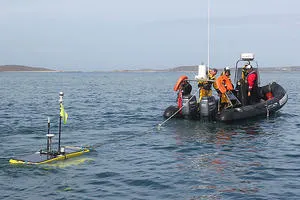
A fleet of seven robotic vehicles were launched into the ocean off southwest England this week, in the most ambitious project of its kind in Europe. The vehicles are aiming to travel up to 300 miles over the next 20 days, and will be collecting scientific data about ocean processes and marine life.
The progress of the vehicles and the project can be followed on the project website.
Co-ordinated by the National Oceanography Centre, the exercise includes battery-powered submarine gliders and novel surface vehicles that are powered by wind, wave and solar energy. All of the vehicles are unmanned, so the only communication with the fleet will be via satellite.
The vehicles will cross a series of physical boundaries in the ocean during their three-week journey. These boundaries are called fronts, and they separate water masses of different properties. The targeted fronts off southwest UK provide ideal conditions for abundant plankton growth, which in turn can attract large numbers of fish, seabirds, dolphins and basking sharks.
The deployed vehicles are carrying a range of instruments for observing these animals. As well as measuring the temperature of the water and the weather conditions at the ocean surface, they can detect the density of plankton in the water; listen for clicks and whistles of dolphins and porpoises, and image seabirds using surface cameras. These data will help scientists map the distribution of the fronts and their associated fauna.
NOC’s Dr Russell Wynn is scientific co-ordinator of the exercise, while Dr Maaten Furlong is responsible for managing many of the vehicles.
Dr Wynn said “Nothing on this scale has been attempted before. The range of vehicles and instruments being deployed at the same time is unique, and they will generate vast amounts of valuable scientific data. One advantage of using robotic vehicles is that they are relatively small and quiet compared to research ships, so they are ideal for making observations of marine life. This new technology is really transforming our ability to measure and monitor the ocean”.
Dr Maaten Furlong said “Over the next few weeks this exercise will test both our new vehicles and their capabilities, and the coordination of a large disparate autonomous vehicle fleet. This is the first time we, along with our partners, have put such a large, diverse range of marine autonomous vehicles in the water at the same time. It is a logistical and technical challenge.
“Each vehicle travels at a different speed and depth, has its own range of sensors, and requires its own pilot to keep watch on its position and activity. Co-ordinating this fleet to achieve the science objected is a challenging task, and will teach us a lot about running this sort of operation. Understanding how to run this type of campaign is essential as our aim in the long term is to routinely deploy fleets of robots to tackle ocean research problems.”
The exercise has brought together a wide range of partners, including scientists and engineers from research institutes and universities, commercial companies, government agencies, and also the UK Met Office and Royal Navy.
A control centre has been set up for the duration of the project at the National Oceanography Centre in Southampton, although some of the vehicles will be operated by project partners from as far afield as California.
Satellite maps of the region are being provided by Plymouth Marine Laboratory, which provides an indication of the location of the targeted fronts. Tidal data from National Oceanography Centre, and weather data provided by Royal Navy operations, are also vital when planning vehicle tracks and activities.
Dr Furlong continued, “We have been extremely impressed with the willingness of the partners to contribute their equipment, expertise and time in such a ground-breaking project. There has been a strong sense of co-operation during the deployment, and a real buzz in the control room as everyone learns from each other about how to operate this new technology. Controlling the vehicles will be challenging, especially as the tides and weather can change so quickly. But that is why we are conducting these trials. It will be an interesting and demanding few weeks.”
At the end of the first deployment most of the vehicles will be recovered at an offshore location using the research vessel RV Cefas Endeavour. Two of the vehicles will then be deployed off Plymouth in an attempt to track fish carrying acoustic tags. These fish are captured, tagged and released by scientists at the Marine Biological Association, who are hoping to better understand how fish use different seafloor habitats, including those within Marine Protected Areas.
NOC has been working with two UK companies, MOST and ASV, to design and build two of the robotic surface vehicles that harvest energy from their environment. The MOST vehicle ‘Autonaut’ uses wave and solar power, while ASV vehicle ‘C-Enduro’ uses wind and solar power. Both have a conventional back-up power source.
Dr Wynn added “It is great to be able to work with and support UK business in development of this new technology, which is clean and efficient. Marine robotic vehicles have a wide and growing range of applications, from science to defence, policy and marine operations. By demonstrating the capability of the new vehicles to collect high-quality data as part of a real science mission, we can support the companies in promoting their new products to potential customers in the UK and overseas.”